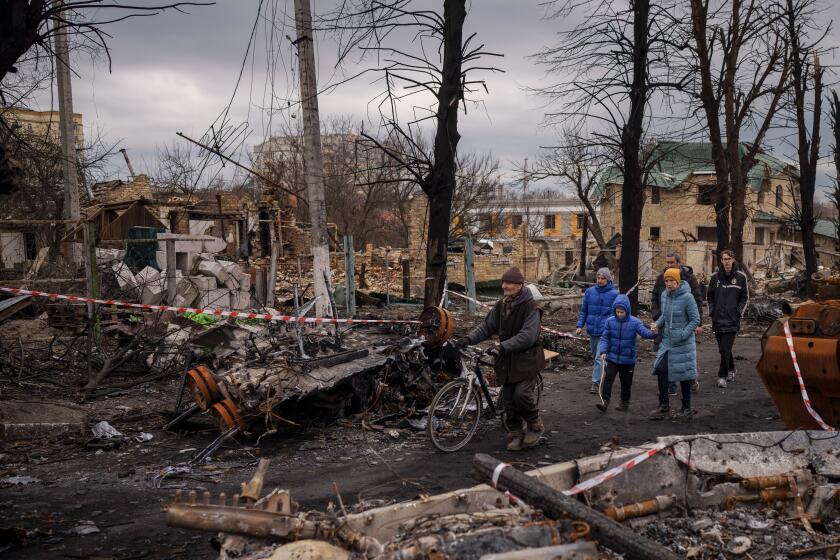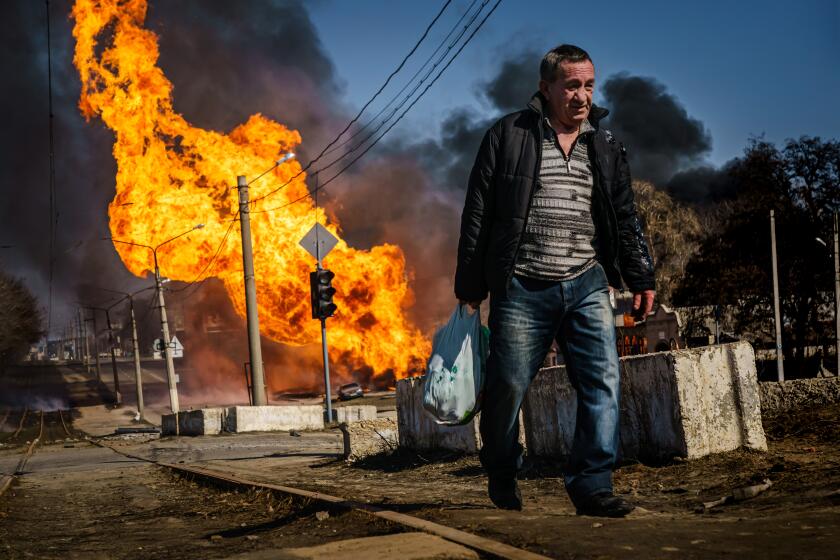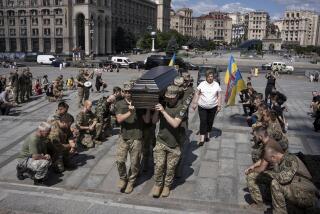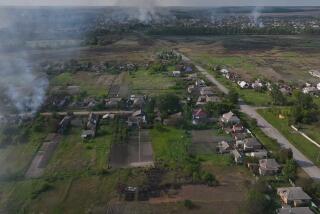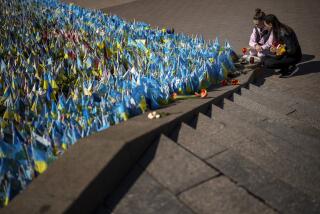Bucha isn’t just a graveyard of Ukrainian dead, it’s a cemetery of Russian weapons
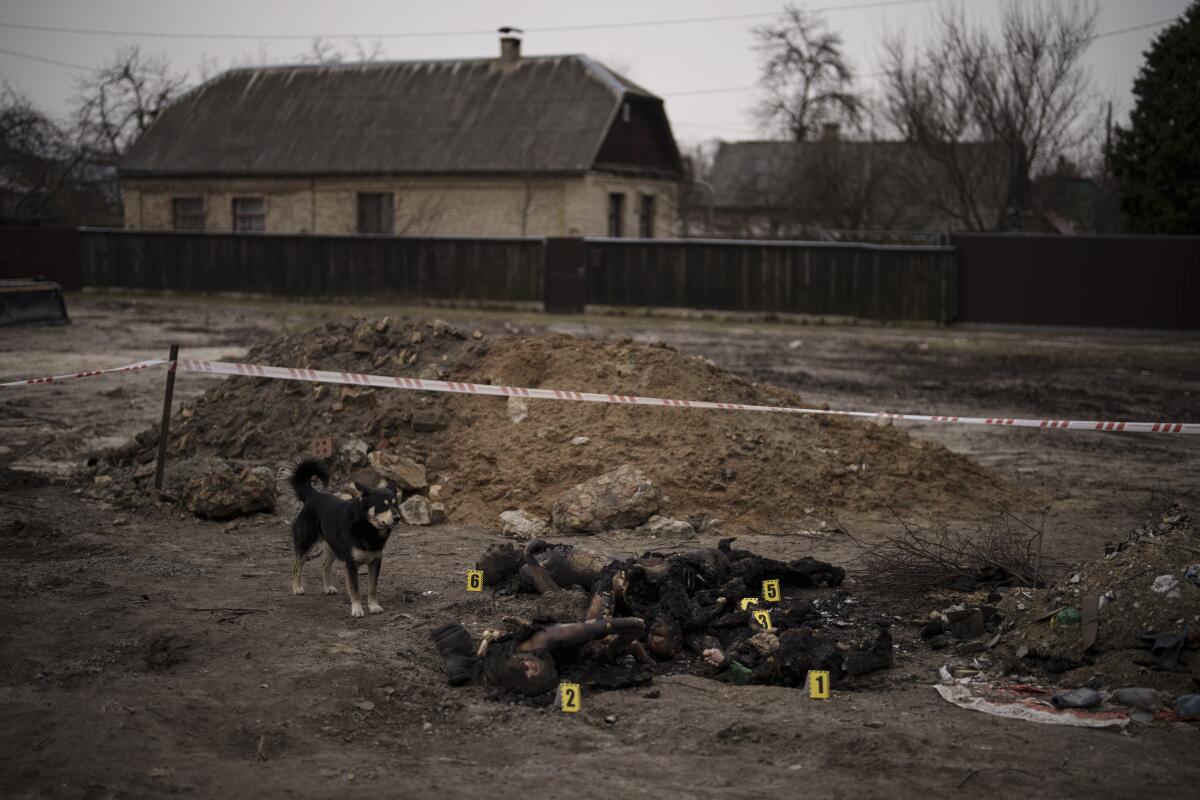
- Share via
BUCHA, Ukraine — The corpses, charred and partially dismembered, lay amid a pile of trash in a lot along the edges of a forest. Tattered remnants of clothing clung to shreds of skin. Who was a man, who was a woman, who was an adult, who a child? This was not possible to determine at a glance. A severed leg, badly singed, was found some distance away.
This tableau was about 100 yards from a playground with swings and slides, nestled beneath a woodsy shade.
A Ukrainian forensic team, each member donning blue plastic gloves, worked with practiced speed. They pushed past a crush of journalists, ducked beneath crime-scene tape and hurriedly gathered the bits and pieces and placed them in black bags. Some mixing of parts seemed inevitable, so intermingled were the cadavers. The workers zipped the bags tight and hoisted them aloft, to be taken to the morgue.
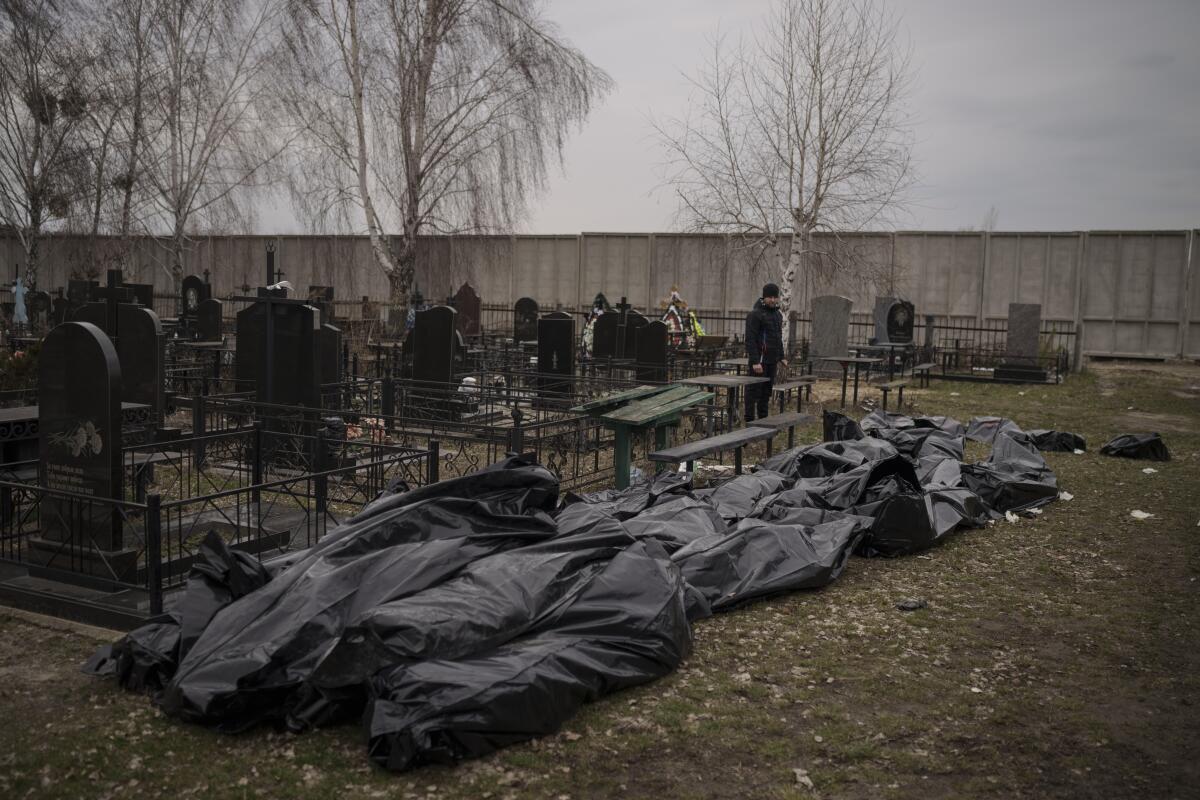
This city northwest of Kyiv, the capital, was a nice place to live, residents say. An idyll of woods, ponds and parks. Bucha retains a semi-rural vibe despite the inevitable advance of urban sprawl: shopping centers, condo towers, health clubs.
Now, Bucha has become notorious as ground zero of what Ukrainian authorities call a Russian war crime, a killing rampage targeting civilians, some found with hands tied behind their backs, apparent victims of summary executions. Video images of victims lying along a street stunned the globe — and gave new impetus to Ukrainians’ demand for additional military aid to fight off the onslaught, and more sanctions against Moscow.
The people “were killed in apartments, houses, blown up by grenades,” President Volodymyr Zelensky told the United Nations on Tuesday, adding that some in civilian cars “were crushed by tanks ... in the middle of the road. For fun.”
The U.S., EU and Britain move to put a greater squeeze on Moscow as Russia defiantly denies war crimes in Ukraine despite mounting evidence.
At least 417 bodies of civilians have been discovered in Kyiv-area towns recently recaptured from retreating Russian forces, Ukrainian officials say. Who they all were, how exactly they perished, are questions that remain under investigation as authorities toil to identify the dead in a war that has stretched into its second month.
Russia has denounced the scenes from Bucha and other nearby towns as fake — a “stage-managed anti-Russian provocation,” in the words of Sergei Lavrov, Moscow’s foreign minister.
Here in Bucha and other suburbs, though, is evidence of how the world, despite a collective outrage fueled by Twitter videos of killings and satellite photographs of troop movements, appears powerless to stop such atrocities. Officials continue the task of collecting bodies from shallow graves, streets, yards and other sites — including the vacant lot from which the six victims were removed on Tuesday. The remains of the six, like those of some other victims, were burned in a clumsy effort to cover up the crime, authorities say.
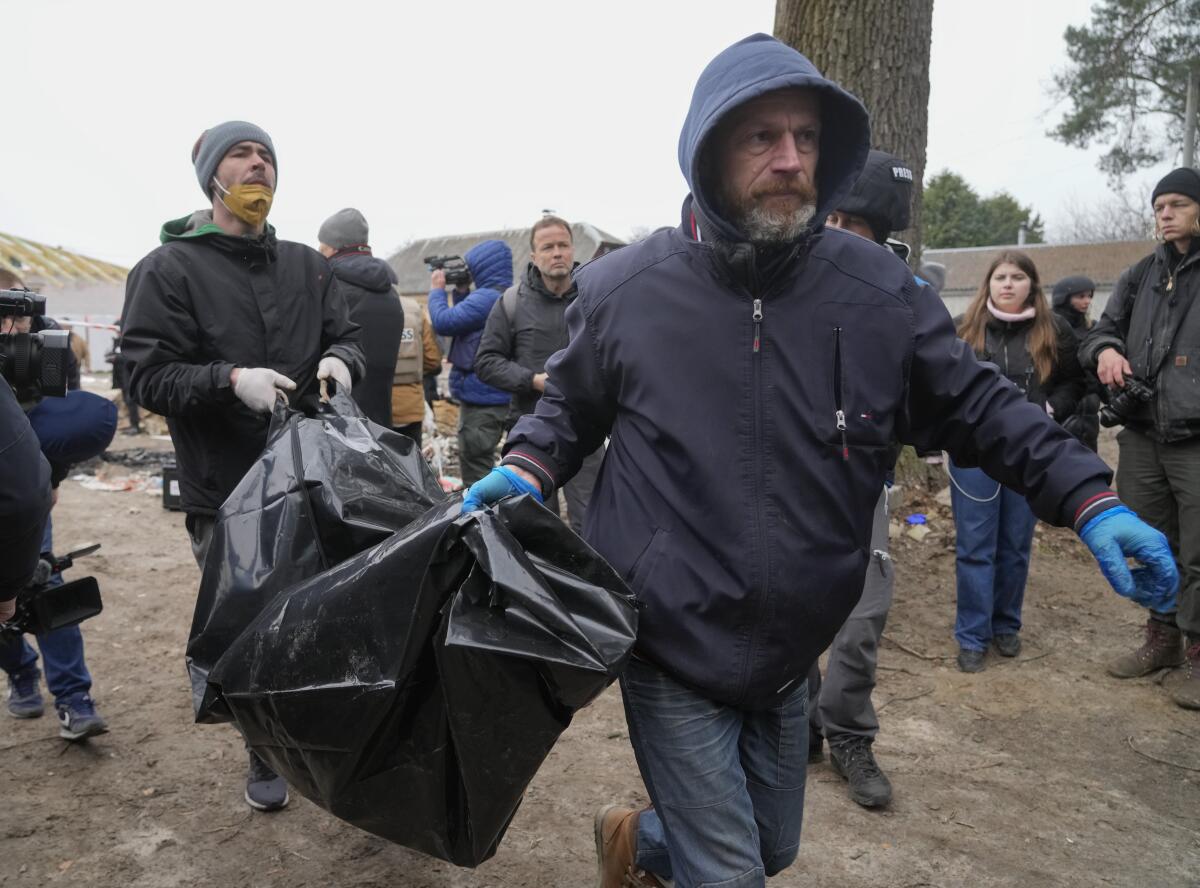
As they gather up the dead, officials and the military are also engaged in another task: clearing up the many mines, piles of unexploded ordnance and other battle detritus left behind in Bucha and other formerly occupied towns. Signs warning, “Danger: Mines,” dot the area. Some buildings may be booby-trapped, the military warns.
But the stray ordnance and equipment littering streets were not left behind deliberately. Their presence is a consequence of Russia’s ignominious battering on the northern fringes of Kyiv and its forces’ subsequent retreat. Bucha is not just a graveyard of Ukrainian dead; it is also a cemetery of Russian war materiel, and possibly the place where Moscow’s apparent intent to storm Kyiv quickly and take the capital ran aground.
One street in Bucha bears brutal testament to the pounding inflicted on Russian hardware, and the failed ambitions of Russian President Vladimir Putin.
The torched vestiges of a dozen or so Russian tanks and armored personnel carriers, and at least one fuel tanker, mark a three-block stretch of the city. The vast scale of destruction seems paradoxical on this tree-lined street, where chickens peck in adjacent yards. Strewn about is a twisted jumble of ammunition, shards of metal, coils of wire, chunks of tires, cartridge belts, tank tracks — one blackened tank turret sits in the frontyard of a house.
It is a scene of obliteration, as though a fire-breathing giant had vented his fury, ripping apart machinery with claws of steel. The wreckage is the result of a Ukrainian ambush, featuring drone strikes, apparently just a few days after the Russian invasion on Feb. 24. How many Russian soldiers were killed in the attack, and how many escaped, is unclear. Among the ruins lies a military boot with splintered bones visible inside.
Experts have been combing the scene, removing possibly dangerous ordnance. But journalists have been invited to tramp through the debris — in a sort of surreal parade — and broadcast across the globe images of a routed Russian column.
The homes along this and other streets are mostly vacant. For Bucha these days is a ghost town. Most residents fled the Russian blitz, joining millions of displaced others. Curtains flutter through the blown-out windows of high-rise apartments where no one lives anymore.
Only about one-tenth of Bucha’s prewar population of about 30,000 remains, the mayor, Anatoly Fedoruk, has said. He has warned townsfolk to stay away until mines and other dangers are cleared, and power is restored.
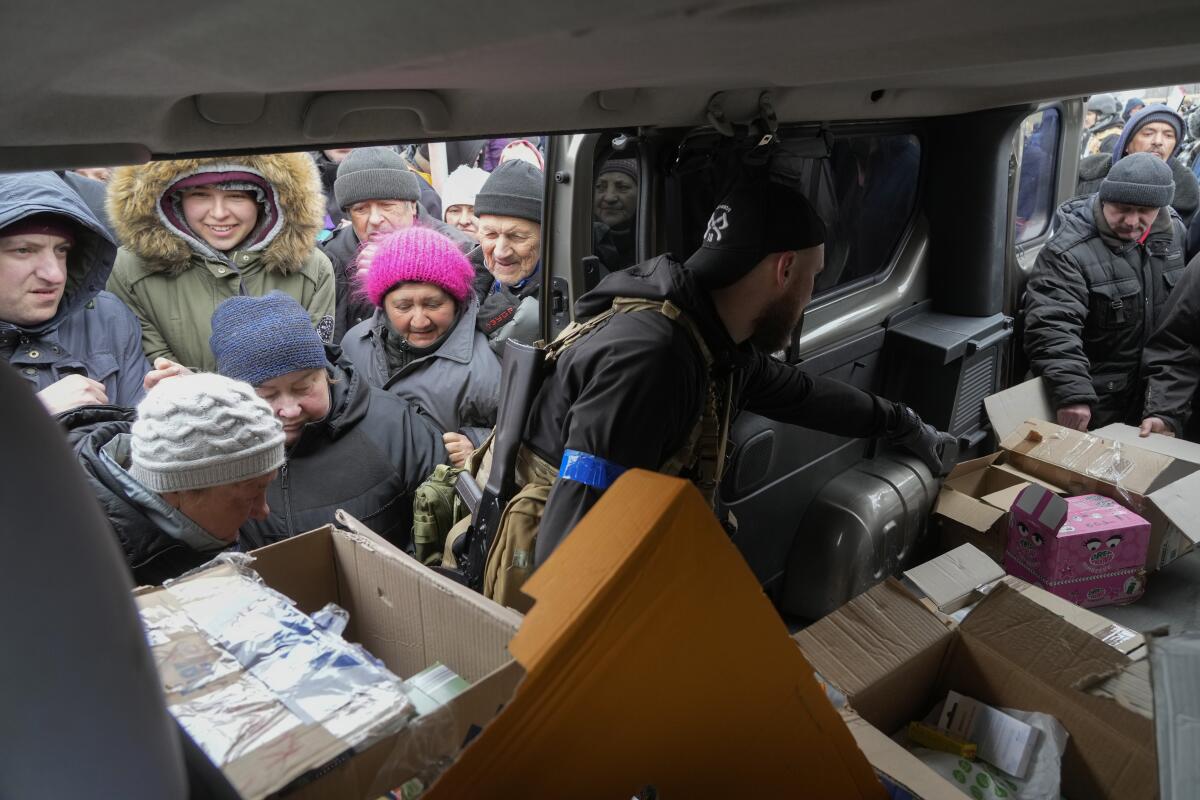
Some residents seeking food and other aid gathered Tuesday outside a shopping center that had been hit by artillery and looted. Bullet shells, shrapnel and broken glass litter the grounds. A scorched power plant stood across the street, its dire condition none too promising for workers looking to restore electricity.
Stray dogs fought over scraps of food in the vacant parking lot.
The Times’ Marcus Yam, no stranger to war photography, gives a first-person account from Ukraine.
Many of the residents huddled outside were older. They were unable, or unwilling, to flee the Russian onslaught. Many have been living for weeks without electricity, running water and heat.
“I would just like to be warm again — to have a hot bath, and to be clean,” said a shivering Lisa Andreshenko, 46, who was among those lining up for aid. “It feels forever since we were warm, had a proper hot meal.”
Snow flurries blew across the commercial strip.
Displaying a measure of good cheer despite the circumstances was Leonid Mutnichenko, a 58-year-old retiree. His family had a secret weapon: An ancient wood-burning stove that he and his mother had almost thrown away, but now — with no heating or power — found to be very useful indeed. He laughed at the craftiness of it all.
He was quick to introduce his mother, Valentina Kusovkova, 80, draped in layers of shawls and greatcoats. She didn’t complain about the cold.
She had bigger thoughts: “We must save our country,” she said.
More to Read
Sign up for Essential California
The most important California stories and recommendations in your inbox every morning.
You may occasionally receive promotional content from the Los Angeles Times.
